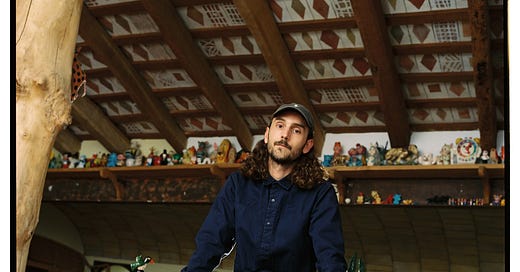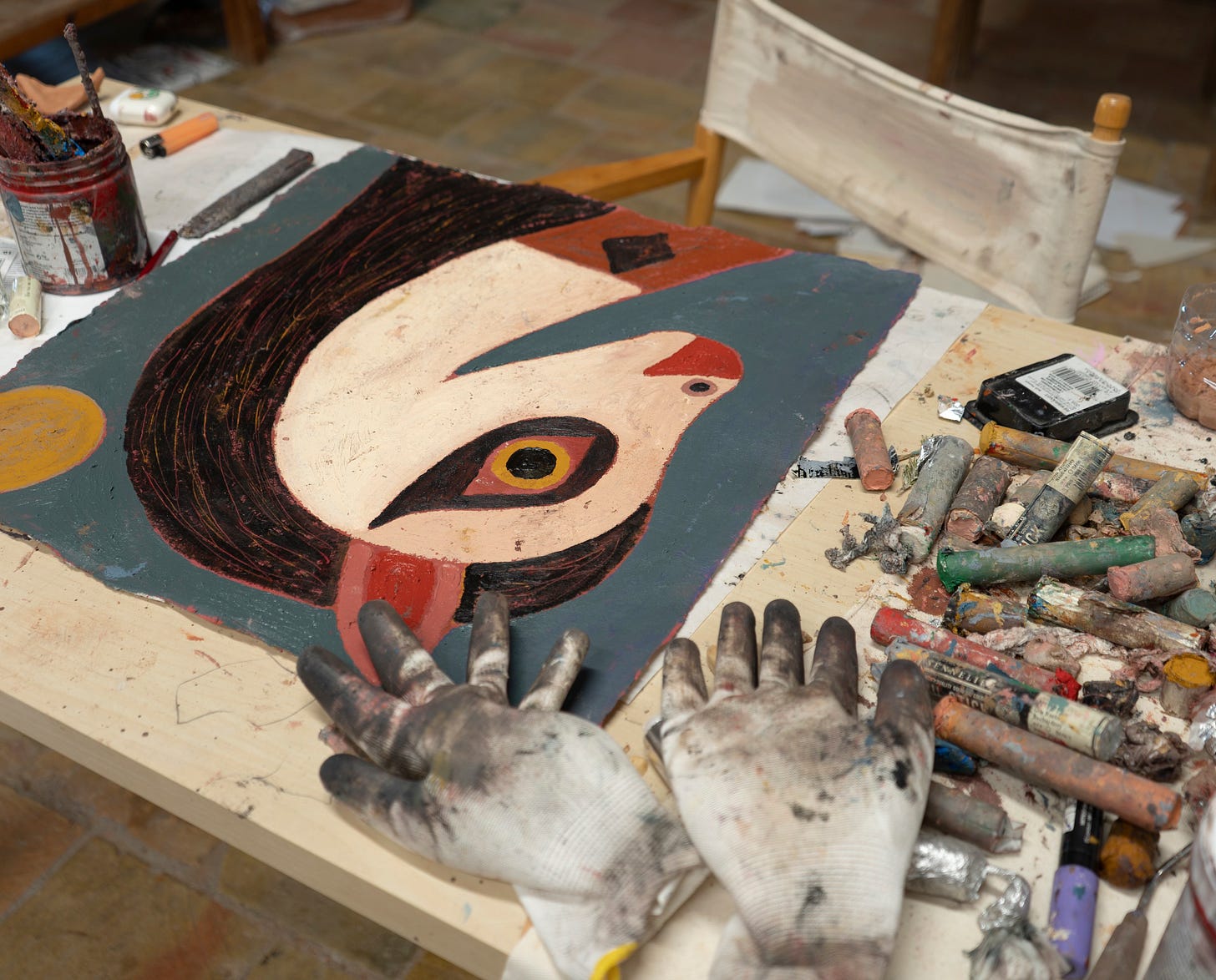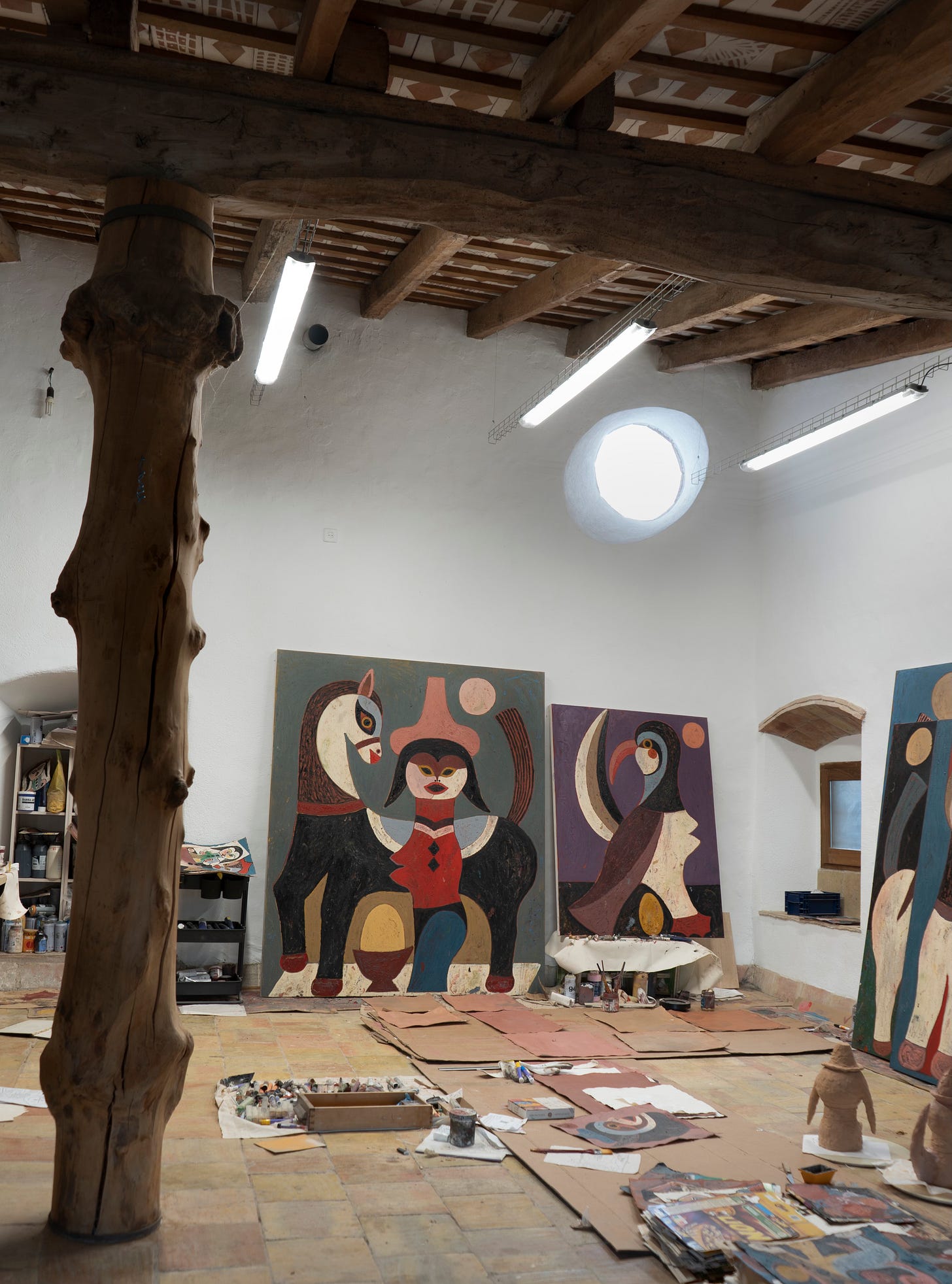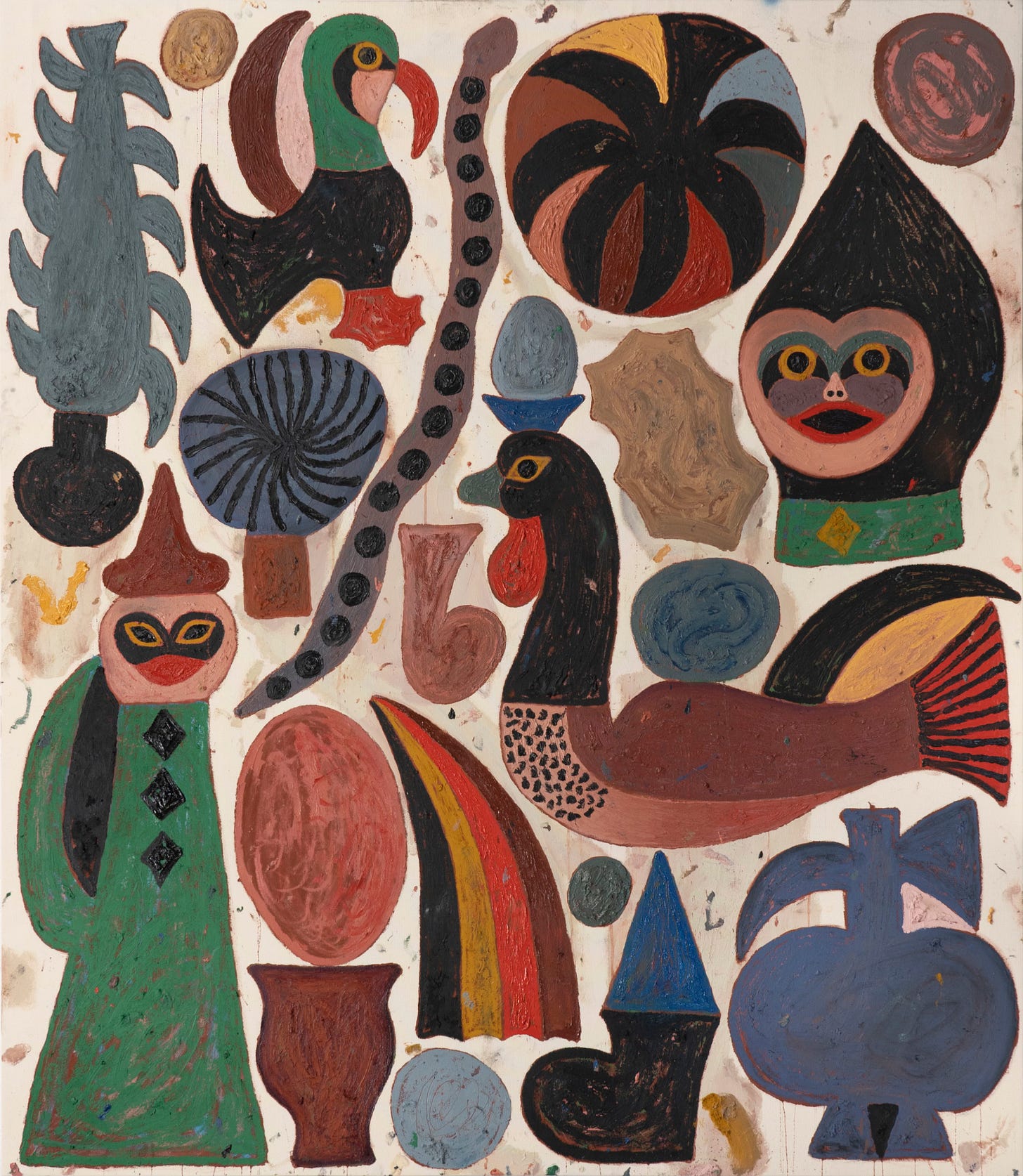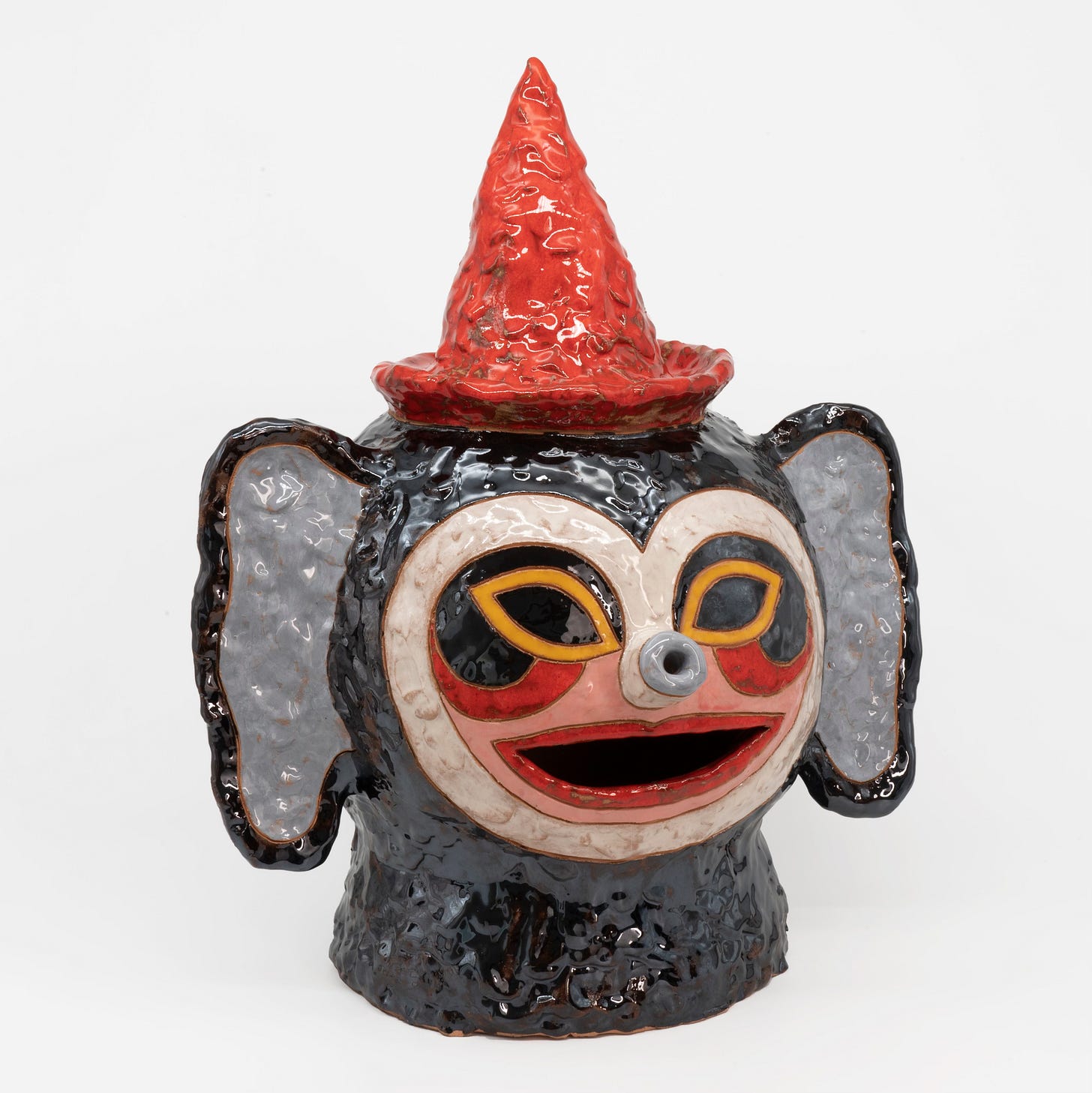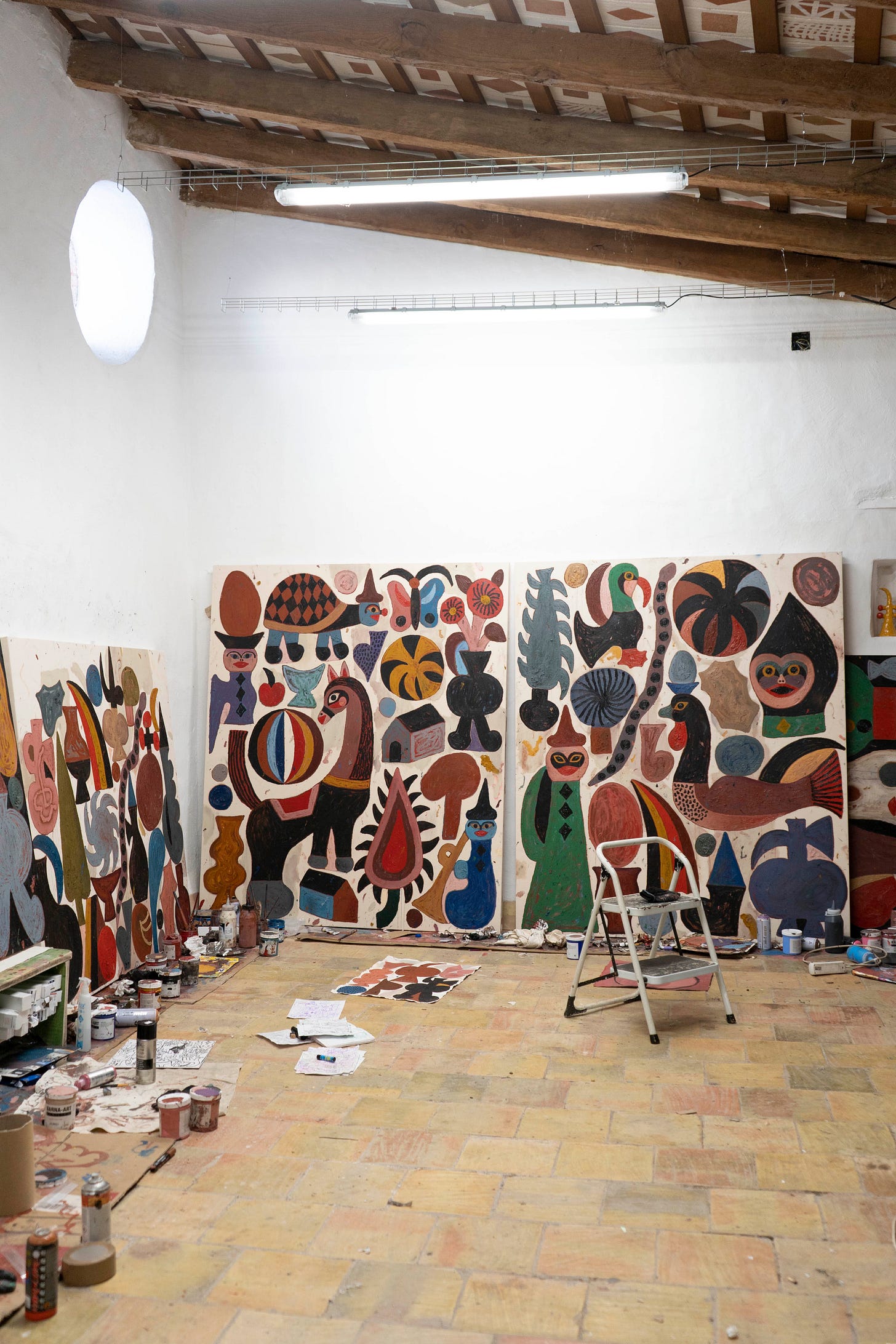Nacho Eterno
The former tattoo artist talks about his recent transition to painting, the impact of working large-scale, and the happiness he’s found in the rural hills near Girona, Spain.
Nacho Eterno (Nacho González, b. 1992) is a self-taught painter and ceramist from Spain, who now resides in the Girona countryside. Formerly a tattooist and muralist in Barcelona, he chose a quieter life to focus on his passion for painting and ceramics. Influenced by nature, primitive art, Folk art, architecture, art Brut, and contemporary currents, Nacho's work exudes an enigmatic charm. His art features unique characters and animals entwined with abstract elements, painted with earthy textures and colors that add an organic and warm aspect to the artwork.
Mepaintsme: You’ve described yourself as self taught and I’m curious as to your development as a painter. Can you tell me a bit about what led you to painting?
Nacho Eterno: I think I've always had the need to paint. When I was younger, I started painting graffiti in my hometown of Valladolid. This led me naturally to the world of tattooing. I started tattooing at home, but also chose to study graphic design, because I didn't think I could make a living from tattooing. When I finished my studies I decided to move to Barcelona. I was 23 years old and I had always been attracted to the graffiti and tattoo scene in the city — working in the city as a tattoo artist in a professional studio was a transcendental moment for me. Even though tattooing was a very demanding job, I always made time to paint murals in the streets. Eventually I got a little lazy about going out and painting, so I started painting more at home.
I always longed to have more time to focus on painting, and that longing became a reality when the lockdown came and I was able to start dedicating the time I had always wanted to it.
I started painting small format work and selling it through Instagram. When the lockdown ended I made the decision to make a change to my career — I stopped tattooing completely to be able to dedicate 100% of my time and energy to painting. This is when I started painting larger format works.
As a result of this change, I decided to leave Barcelona and look for a less noisy place to live with my girlfriend. We moved to an old farmhouse in a rural area near the city of Girona, where we currently live and where I also have my studio.
Our home has a curious history — we live in an old stable where the animals were kept and the studio (which is upstairs) was the barn. We are surrounded by fields of apple and pear trees. At first it was a little strange to be so isolated, but now I wouldn't change it for anything.
MPM: There are a number of things that I love about your work — your flattening of space, your handling of paint, your use of symbolism — but I first wanted to ask you about your earthy palette which feels (not having been to Spain) indicative of Spain. Do you see your palette as reflecting your homeland?
NE: I may have been influenced by my environment when choosing the colors but I think it's something that has been unconscious. At the beginning, when I was a muralist, I used more intense and saturated colors. I think this was influenced by tattooing. But little by little I have been finding nourishment from other, more pictorial sources of inspiration that are represented in a more organic and earthy range. My intention is to reduce the use of vibrant color and move towards more sober ranges and combinations.
MPM: You mentioned your previous profession as a tattoo artist. Spatially and compositionally your work feels influenced by vintage tattoo flash. Is this art form an influence on your work?
NE: Of course it is something that has marked me a lot, especially when it comes to drawing and understanding the distribution of elements and colors. I was already using this type of flash composition in my murals. It’s a way of working that allows you to improvise and add elements, forming a kind of "Tetris". It also allows you to put all your ideas on the same image.
MPM: You’ve been painting for a few years now and the scale of your work has increased exponentially. Did your background in mural art allow you to feel comfortable scaling up?
NE: Yes, I guess it was something that helped me when I started painting large format paintings. I think you learn a lot from painting on walls, both in proportion and color choice. Last year I did the largest piece I have ever done to date, which was the main piece of the solo show I had at Delimbo Gallery. It was a polyptych composed of 4 pieces, 200 x 170 cm each, which I painted in pairs, and I didn't see the final composition until the day of the opening. That's when I realized the impact it had on me to see a work of mine of that size, and it's something I'd like to do whenever possible.
MPM: When I first encountered your work I saw your sculptures. This ongoing body of ceramic work seems to have such a natural relationship to your paintings. Can you talk a bit about the conversation between these two mediums for you?
NE: Sculpture has always been very appealing to me. I think that the forms I usually make in painting also work in volume, and that the two things complement each other well. Usually the ideas come from the paintings and go into the ceramics, but sometimes the ceramics inspire me to discover new forms and bring them into the painting.
When I started to think beyond painting, I thought about working with carved wood. But it was by chance that I tried ceramics first, and I got hooked, It is definitely something that keeps me motivated.
I actually have in mind as a future project to start making larger pieces, and try new techniques like Raku.
MPM: Your vocabulary of abstract symbols and the characters that inhabit your work feel completely charged with an almost shamanistic potency. Can we read anything into this language you’ve developed?
NE: Honestly, I am a person who does not believe in anything religious or spiritual, but the whole religious imagination, in general, has always been something very attractive to me.
When I was little, I really liked the universe of ancient Egypt, and my parents gave me a book, and I spent hours drawing the hieroglyphs and the gods like Horus or Anubis. They impressed me a lot because they were half animal, half man. As time went on, I discovered more ancient cultures and folklore from different parts of the world. I think that is why you can see elements of spirituality in my paintings.
MPM: I've noticed in some recent works there are hints of a more illusionistic space which is interesting. Is this the direction you see yourself moving?
NE: Well, right now what I'm looking for is to simplify the forms even further. This year, I’m trying to experiment more with oil painting, and looking for new ways to solve things in a more spontaneous and loose way. Focusing on the use of paint, working more on the textures that the material itself gives you and playing more with the paint — to enjoy the process as much as possible.
MPM: Outside of your works being included in Stray Passages, are there any other projects that you have going on now or coming up that you’d like to mention?
NE: At the moment I’m working on pieces for a solo show in Denmark, which will be in August, and at the end of the year I'm going to participate in a group show with Allouche Gallery in NYC. This will be the first time I exhibit in the city and I'm very excited about it. I was there a couple of years ago and I was very impressed by the number of galleries and how it was possible to see the work of so many artists that I love, there is a high level.
Nacho Eterno’s work is currently on view in the group presentation, Stray Passages, at MEPAINTSME.


